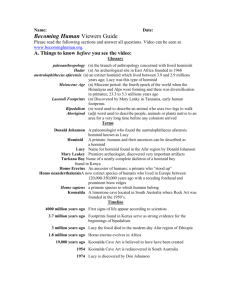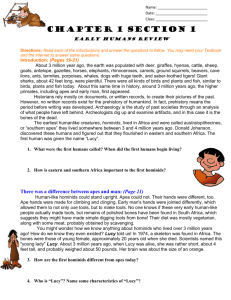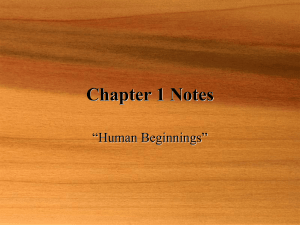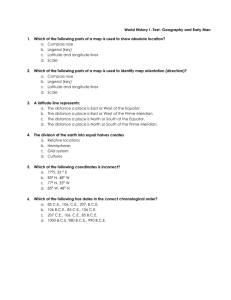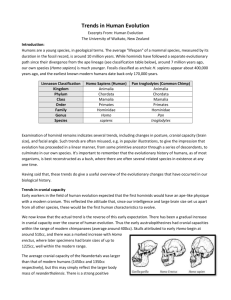Discoveries in Africa and Beyond
advertisement
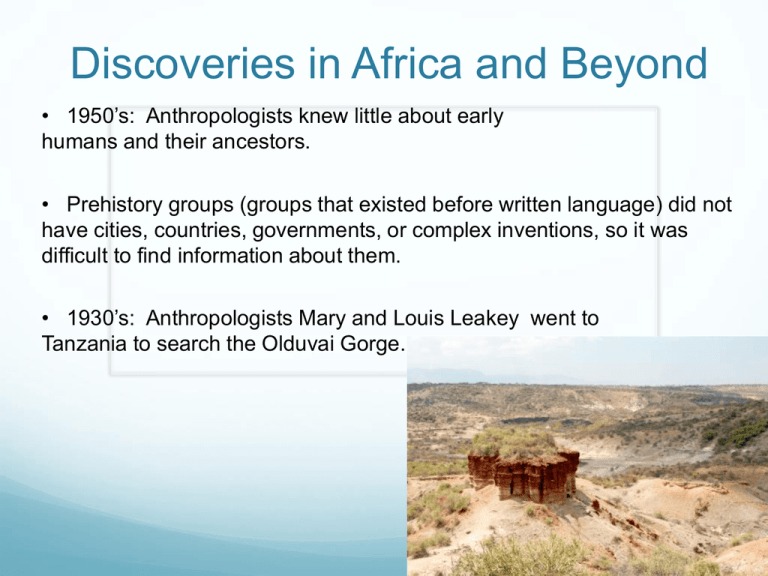
Discoveries in Africa and Beyond • 1950’s: Anthropologists knew little about early humans and their ancestors. • Prehistory groups (groups that existed before written language) did not have cities, countries, governments, or complex inventions, so it was difficult to find information about them. • 1930’s: Anthropologists Mary and Louis Leakey went to Tanzania to search the Olduvai Gorge. The Leakeys found ancient tools chipped from stone. This showed that whoever had made them had learned to develop technologies to help them survive. 1959: Mary Leakey finds the skull of an early hominid. Humans are the only hominids that live today. http://www.talkorigins.org/faqs/homs/eurydice.jpg 1974 – Ethiopia: Donald Johanson discovered enough remains to piece together a whole skeleton which he named “Lucy”. They estimate “Lucy” to be at least 3 million years old. http://www.reocities.com/Athens/Agora/7951/lucy.jpg “Lucy” was about 4 feet tall Evidence of Early Hominid Groups Scientists and anthropologists have established that a number of different groups of hominids lived over the course of several million years. They call the earliest group of hominids australopithecines (ex. “Lucy”) 2 million years ago, a group of hominids known as homo habilis emerge. By studying stone tools, anthropologists have concluded that Homo habilis used their tools for purposes such as cutting, scraping, chopping or sawing plants, animals, and wood. Homo erectus also appeared 2 million years ago. They were given the name “upright man” because their skeletons showed they were upright walkers. Homo erectus: 1. larger brains and bones 2. smaller teeth 3. greater range of capabilities 4. thought to be first hominids to learn how to use fire Homo erectus remains have been found in Asia and Europe, so scholars believe they were the first hominids to migrate out of Africa. http://realhistoryww.com/world_history/ancient/images_eman/erectus.jpg Scientists believe that around 250,000 B.C.E. to 100,000 B.C.E., Homo erectus disappeared… 250,000 B.C.E. 100,000 B.C.E. 1 C.E. C.E. B.C.E. At this time, Homo sapiens appear. (that’s us!) Out of Africa Theory: Homo sapiens first lived in Africa then migrated. Others believe that Homo erectus developed into Homo sapiens. Two groups of Homo sapiens: • A group known as Neanderthals • Earliest modern humans Between 50,000 B.C.E. and 30,000 B.C.E, Neanderthals disappear… 50,000 B.C.E. B.C.E. 30,000 B.C.E. 1 C.E. C.E. Donald Johanson was with another researcher, Tom Gray, when he began finding pieces of Lucy’s skeleton. Lifeline Question: How would you describe Johanson’s reaction to their discovery? Primary Source: “[Gray] picked it up. It was the back of a small skull. A few feet away was part of a femur; a thighbone… We stood up, and began to see other bits of bone on the slope; a couple of vertebrae, part of a pelvis – all of them hominid. An unbelievable, impermissible thought flickered through my mind. Suppose all these fitted together? Could they be parts of a single, extremely primitive skeleton? No such skeleton had ever been found – anywhere. ‘Look at that,’ said Gray. ‘Ribs’ A single individual? ‘I can’t believe it,’ I said. ‘I just can’t believe it.’ - Donald Johanson Bubble Organizer: Homo sapiens Neanderthals australopithecines Hominids homo habilis Homo erectus Earliest known humans Think – Pair – Share: There will be a question given. I want you to: 1. Think about the question individually 2. Turn to a partner and share your thoughts 3. Then share with the class What is the best dessert you have ever had? Continue… Think – Pair – Share What did Johanson speculate about the relationship of the bones he found? What types of obstacles do historians have to overcome to give a straightforward account of events? How might they do this?

